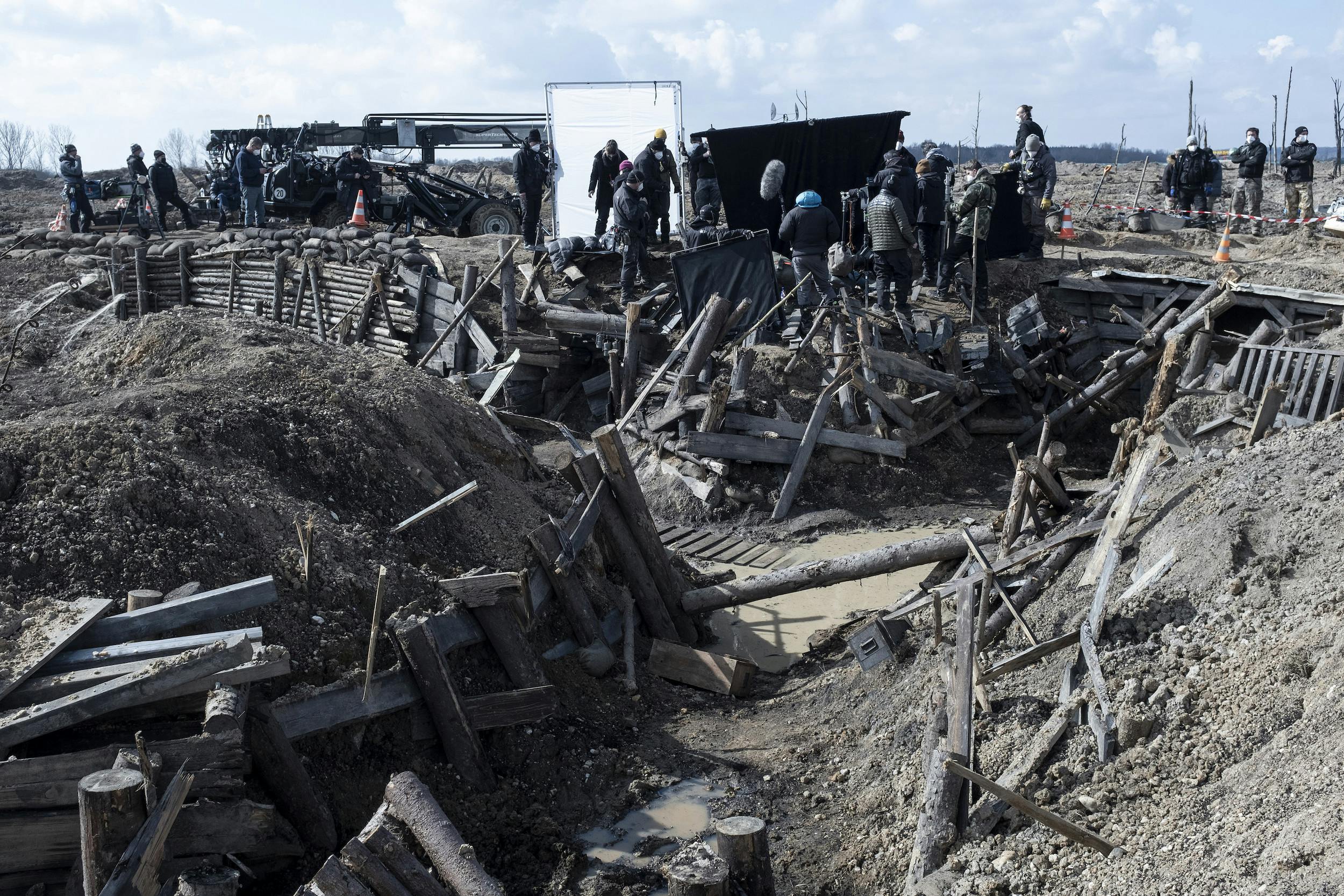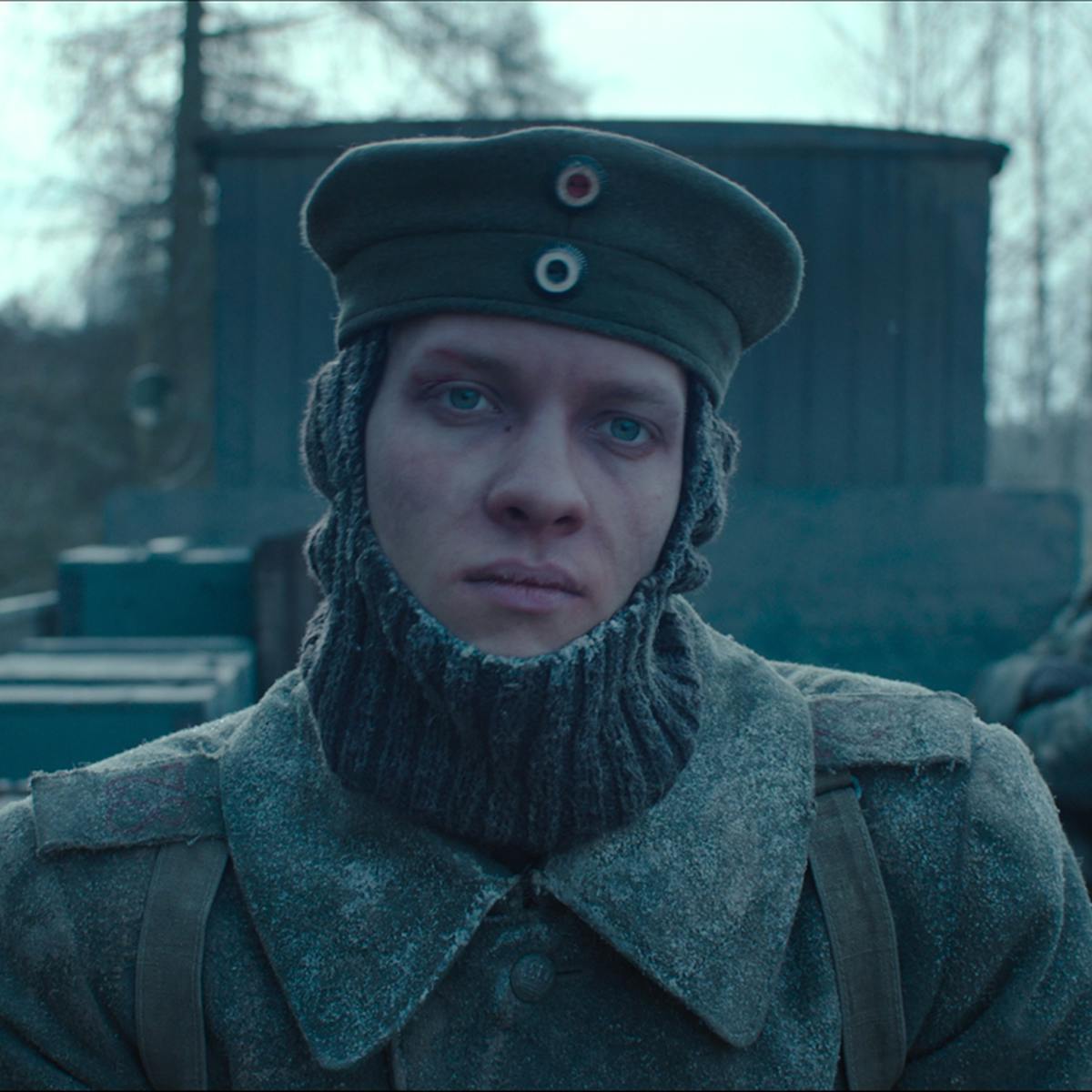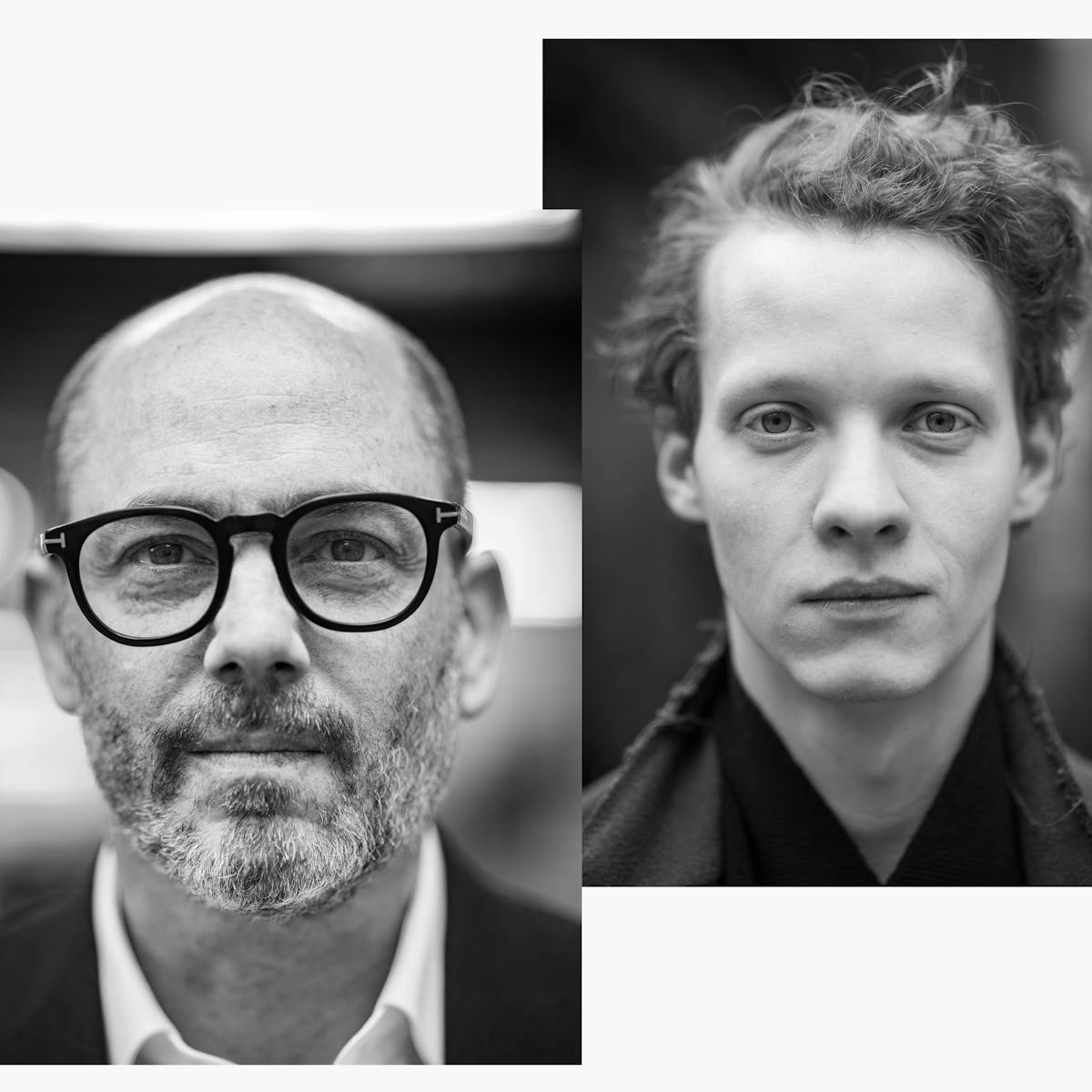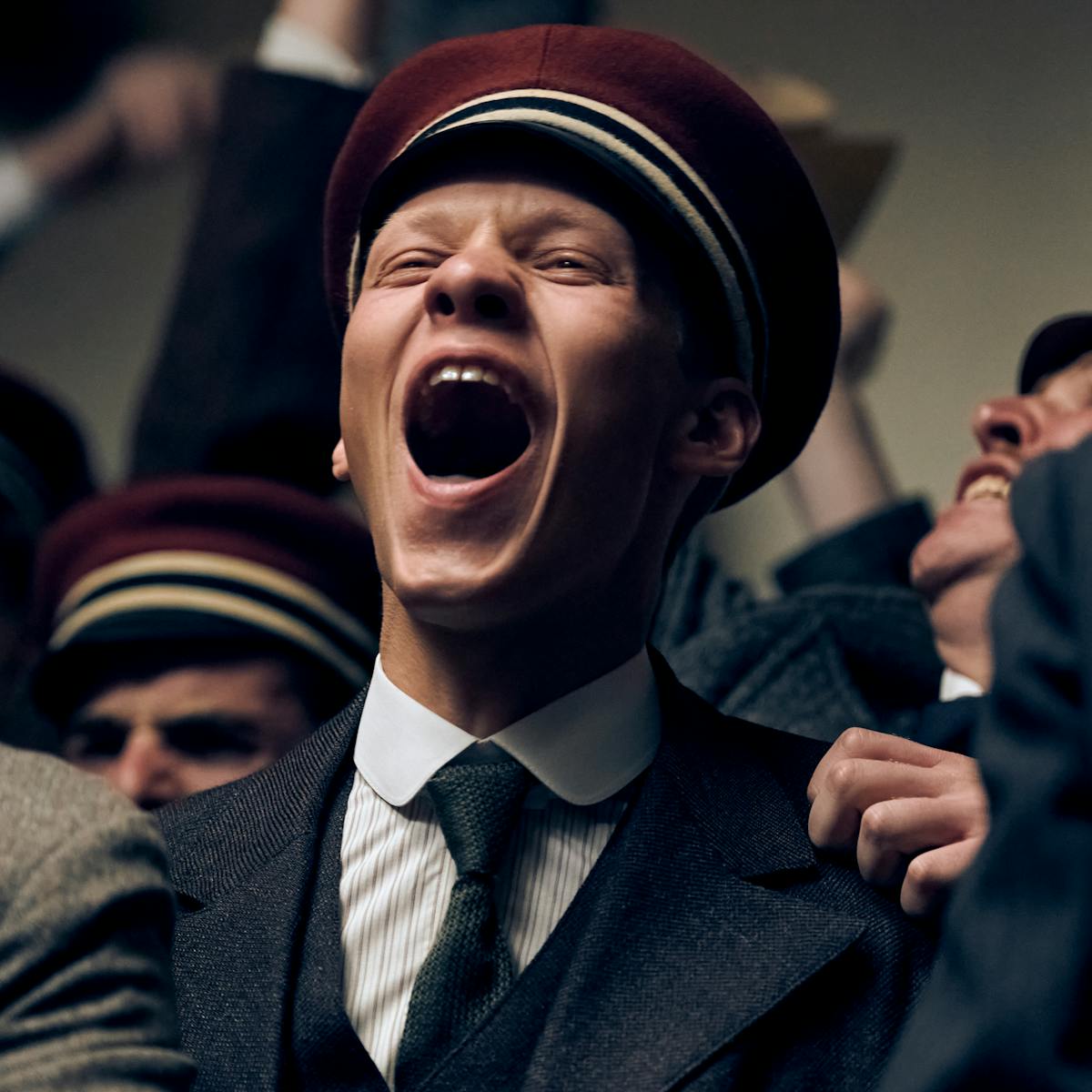Brian Williams moderates a conversation among the film’s key players.
All Quiet on the Western Front’s composer Volker Bertelmann thought he was done recording his score when he got some feedback from writer-director Edward Berger: “I want you to destroy the pictures. I want to have a snare drum player that can’t play the snare. I want to have music for Paul Bäumer’s stomach, and I want you to do something that you’ve never done before.” Bertlemann accepted the challenge, composing a short, heart-wrenching sequence of music that, alongside the film’s stunning visual sequences, drives home the film’s timeless message: War is brutal and should never be romanticized.
Across the board, the craftspeople and actors of the powerful World War I drama adopted Berger’s challenge to push themselves further in service of the film’s universal and still pertinent story of Bäumer, a young German man who happily enlists only to confront unrelenting terror and violence. An adaptation of Erich Maria Remarque’s 1929 novel, All Quiet on the Western Front has been met with critical and audience acclaim: The film is currently nominated for nine Oscars and already has taken home seven BAFTA awards, becoming the British Academy’s most-winning film this year and the most-winning non-English language film in BAFTA history.
After a recent screening of All Quiet on the Western Front at the Academy Museum of Motion Pictures, journalist and television news anchor Brian Williams moderated an interview with Berger; producer Malte Grunert; screenwriters and executive producers Lesley Paterson and Ian Stokell; makeup and hair designer Heike Merker; composer Volker Bertelmann; sound designer Markus Stemler; visual effects supervisor Frank Petzold; and actor Albrecht Schuch, who plays Paul’s friend and mentor, Stanislaus “Kat” Katczinsky.
An edited version of the conversation follows.
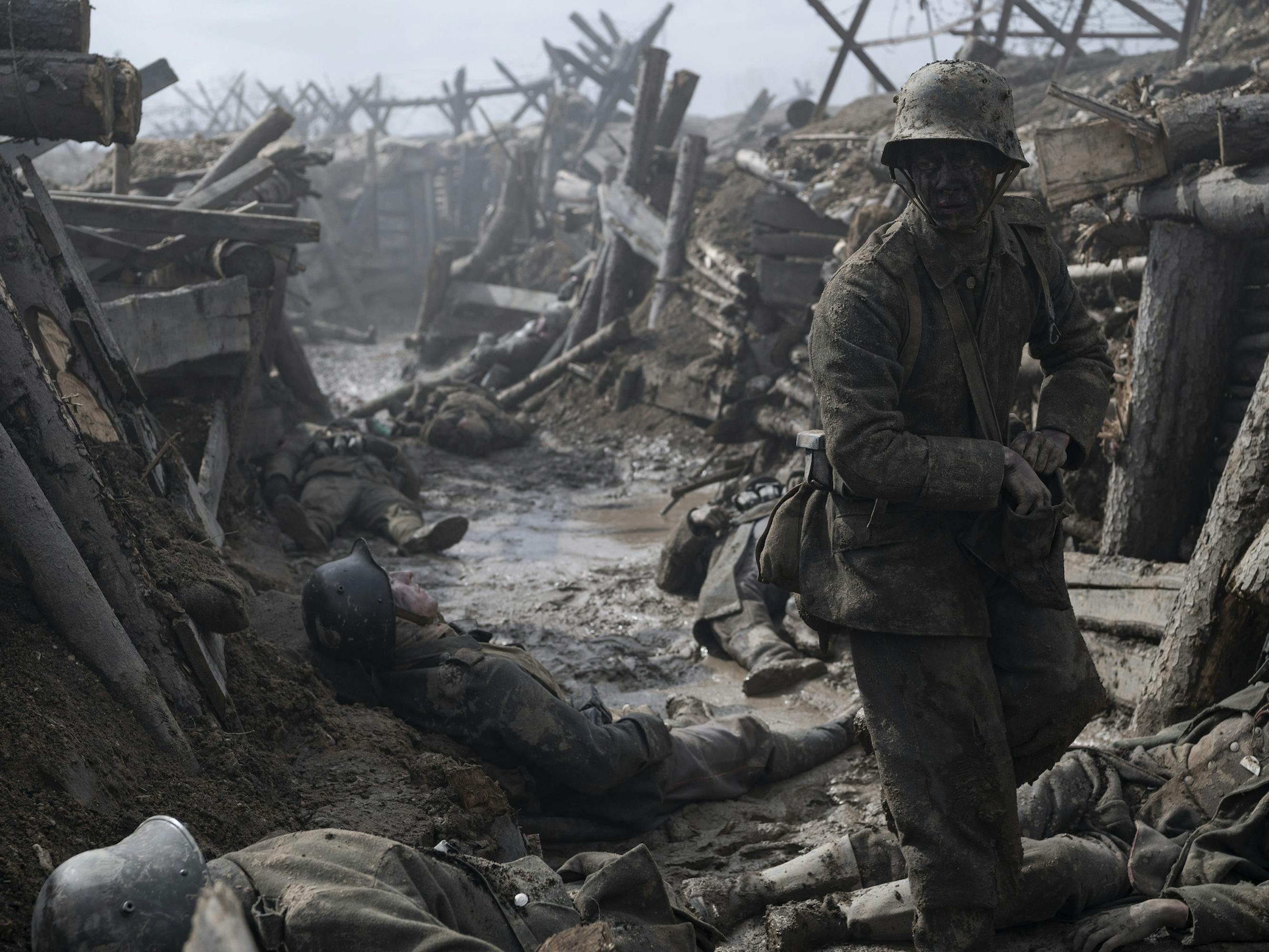
Paul Bäumer(Felix Kammerer)
Brian Williams: Edward, perhaps your toughest critics are those who have chosen to put on the uniform of their country. Talk about authenticity to you and what you saw as your charge.
Edward Berger: Well, we felt primarily that we wanted to give you the very subjective experience of being there with Paul, the feeling of being grabbed by the coat lapels and dragged through the mud with him. And we try to do a lot of that with just one camera because we thought, Okay, that’s Paul, he has one set of eyes. It’s either going to be his face or what he sees or who he’s talking to. It makes it a visceral physical experience.
Tell the folks about shooting locations, where you ended up, and what the actual conditions were.
Berger: We shot this movie close to Prague in a former Soviet Union airfield. We basically dug up everything and in the beginning, we realized that because it was snowing and raining, we started drowning in the mud, basically. One night, after rehearsal, I got into my car and I was waiting for my [cinematographer James Friend] and he didn’t show up. I’m like, Where is he? What’s he doing? So I went outside and suddenly heard these calls like, help, help. And I realized he was stuck up to his hips in the mud.
We got a crane to get him out, but it was getting dark. We’d [nearly] left him there overnight in the freezing cold. It was only then that we realized, Wait, if we sink into the mud, the actors and the equipment are going to sink into the mud. How are we going to shoot this? And then we realized we were going to have to build fortified roads where the actors could run and we could track them in our tracking vehicles and run beside them. So we packed all the mud with Caterpillars and then dressed it again with fake mud. That’s the way we were able to shoot it eventually. But it took us a while to figure out.
Malte, there is a quote from you that I read last night that knocked me out and so accurately describes what you were able to carry out. You say, “The violence must never be comic, it must not be cool in any way. The violence has to hurt when you see it.”
Malte Grunert: It’s something that Edward and I talked a lot about. Remarque’s novel, if you transpose it onto the screen in a copy-paste mode from his words, is unbearably violent. One of Remarque’s themes is that the experience on the western front, even if it doesn’t kill people physically, it kills them inside. Even the survivors are a lost generation as they come back home and the social fabric of their families and friends is torn because they can only relate to people who have experienced this amount of violence.
To us, it was important for the film to be violent and to be visceral. At the same time, it was very important to us that an audience of 15-, 16-year-olds would be able to go and see the film as that’s very much the age of the main characters who go to war thinking they’re going into an adventure. So we wanted to be able to reach that audience and finding that balance was something that we thought about a lot.
Lesley, that’s exactly what I wanted to raise with you. It will have to be explained to younger viewers of this film that there was a day when you couldn’t imagine being an able-bodied young man not going off to war, that these graduating students could not wait to get that uniform, regardless of who had worn that uniform before them.
Lesley Paterson: That was a very important thematic essence of the entire film. Certainly, the traveling back of the uniform, the uniform representing more than the man, was the essence of that opening sequence. It’s just very poetic and timely. In fact, a few weeks ago I shared with Malte that in Russia, they’re repurposing uniforms as well. So times have not changed, which is incredibly depressing.
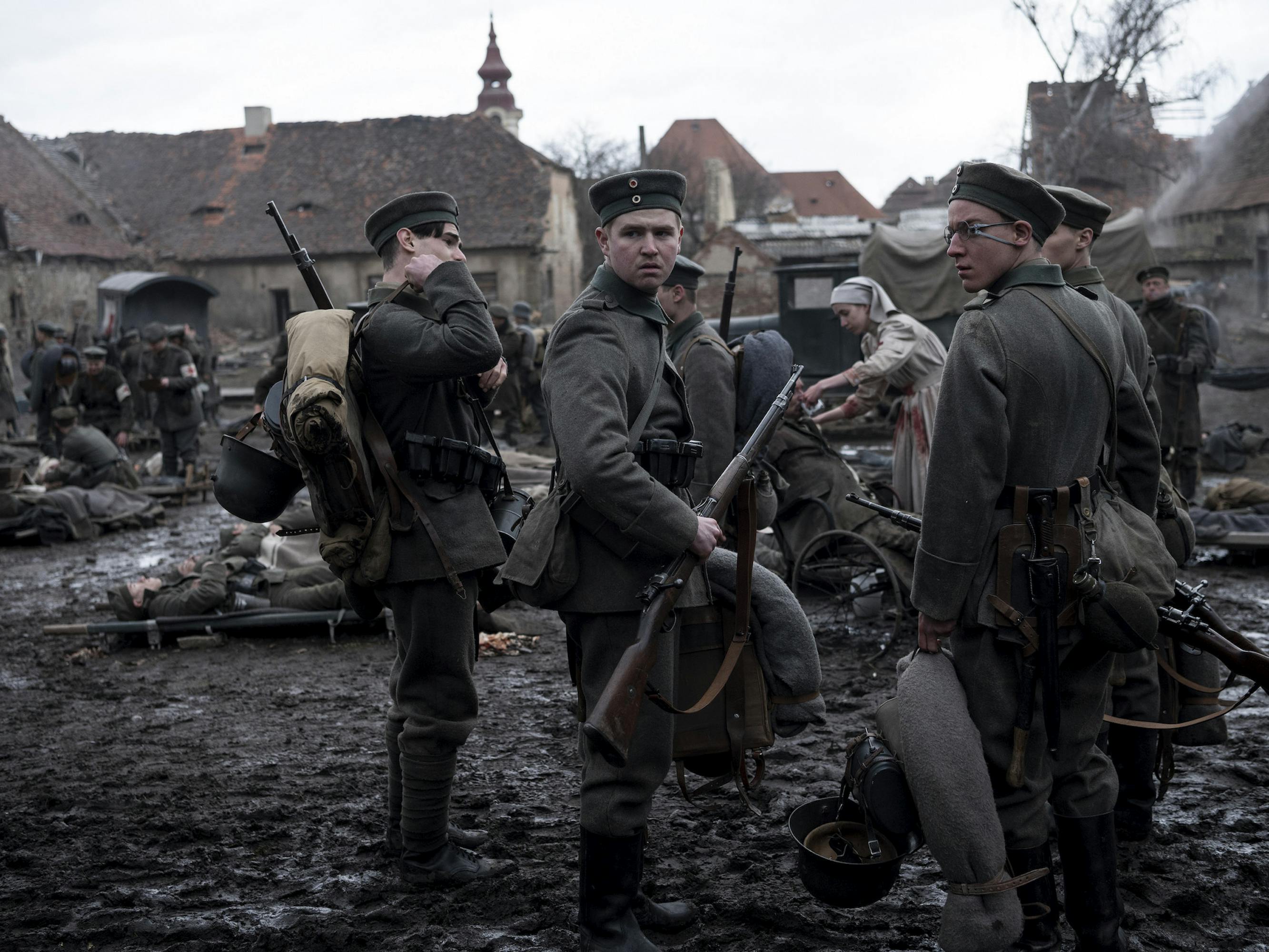
Albert Kropp (Aaron Hilmer), Franz Müller (Moritz Klaus), Lugwig Behm (Adrian Grünewald)
Heike, tell me, how does one do [hair and makeup] touch-ups in the circumstances we just saw? How does one begin to think about continuity, shot to shot, day to day, when the stuff of your craft is blood, mud, and gunpowder?
Heike Merker: I can just say everything was very tough. On the battlefield it was easier to approach, but, in the trenches, it was muddy and very narrow, so keeping track was definitely hard work. But apart from this, it is also a craft. And as a makeup and hair designer, you are used to keeping the continuity. In this case, we had continuity with dirt and different colors. For me, the approach to the movie and the makeup was always like a painting. Sometimes I thought, I’m just a painter on the battlefield.
Indeed, you were. Albrecht, were conditions as horrible, as abhorrent as they appeared to us watching this film?
Albrecht Schuch: I was smoking for 25 years. I quit on this project. I didn’t plan to; I had to. That was how physical it was in terms of running with heavy gear on your shoulders. I think it was Felix, one day after they finished shooting, he put his whole gear on a scale and it was 100 pounds. Soaked with mud, with blood — of course superficial blood. And wet, of course.
Wet wool is uncomfortable, deeply so. As Steven Spielberg did in Saving Private Ryan, he got that cast together and they quickly learned they were going to be cold and they were going to be wet. So this is clearly how all great directors work.
Schuch: I think it was more of a challenge to forget about the wonderful team taking care of you, waiting there with the blankets and hot tea and the warmhearted energy they spread all over the place. It was more of a challenge to tell yourself, “Okay, this is not what Kat went through in that very moment.” I felt surrounded by such a wonderful team. Everyone was so precise in their craft and their vision. And James [Friend] the other day put it rightly when he said that he felt as if everyone was making the same movie. It sounds weird, but when people are coming together, everyone has his vision, and sometimes it’s hard because people try to push their own visions through. But everyone listened to the other’s visions.
Berger: Just to tell you what an amazing group of young actors it was: I remember one of the early shooting days, there was a scene with rain in the movie. In the morning I had said, “Listen, we’re just going to turn on the rain and we’re going to keep shooting, and if we don’t do it today in this way and just shoot, it’s going to take us three days. So why don’t we do it in this one day?” I cut most of it out, but these guys were 12 hours in the rain. Then on the last take, I said, “We’re going to need one more take. Are you ready for it?” And they all burst into song, egging each other on. That was the spirit they brought to this movie — sticking together and bursting into song even though they were freezing.
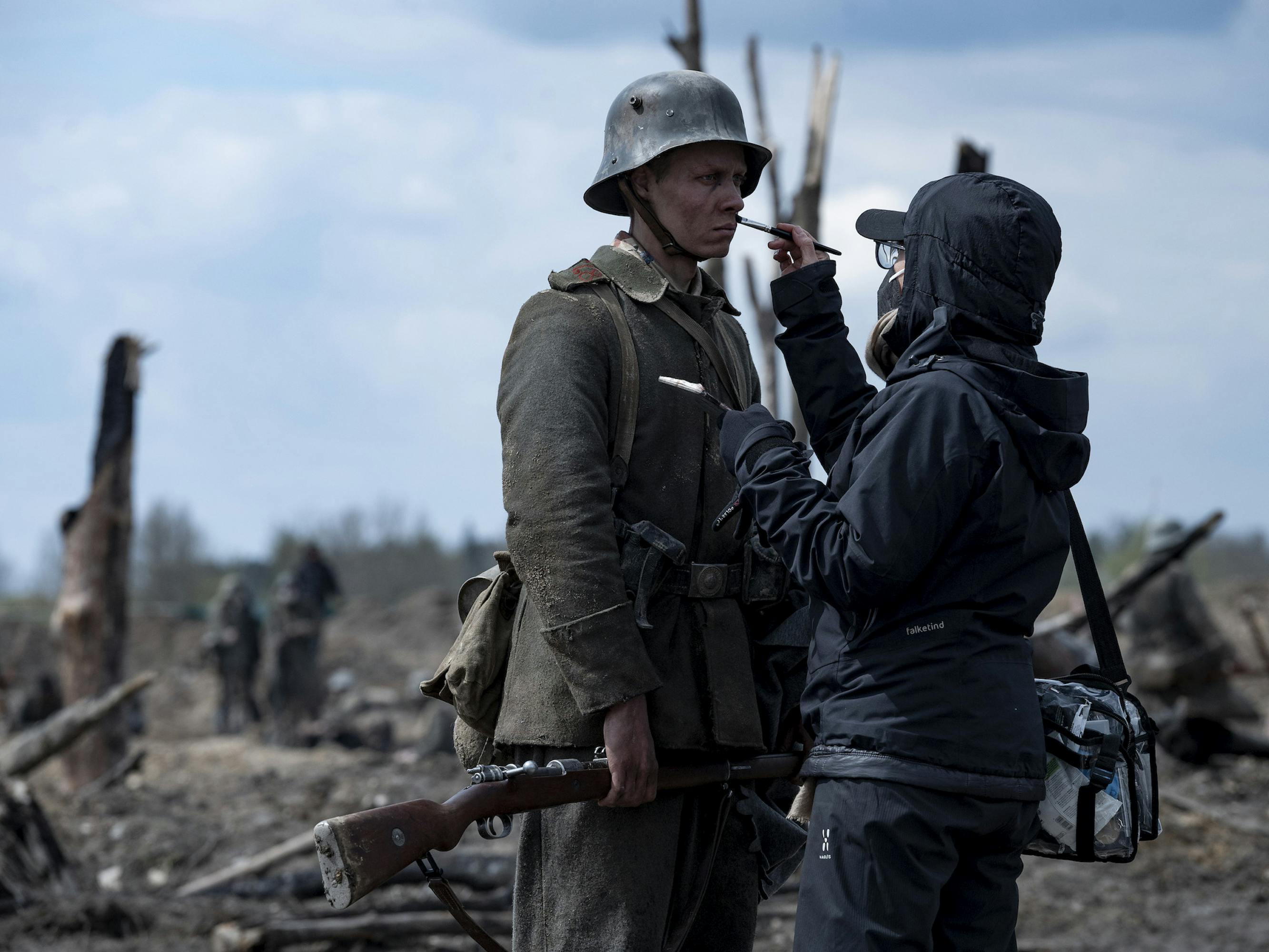
Felix Kammerer and Heike Merker
I thought it was essential that this was a German production. It’s endemic to the film — this story from this viewpoint. There have been other attempts [to adapt the novel] since this book [was published], but I think the reason this will land and last with audiences is the native tongue treatment from the German side.
Berger: For us, the language is almost a superficial issue, but it is important for authenticity. When I talked to Malte, I said, “We’re going to have to make this movie more German,” because of our history. Germany brought two world wars in the last century and that brings a lot of responsibility, a lot of guilt and shame. We felt it’s our opportunity to talk about that responsibility. We have inherited the D.N.A. of those world wars and we wanted to talk about it and thought it might be an interesting addition to the dialogue between our countries.
Ian, let’s go back to the story. Just more than two decades after “the war to end all wars,” soldiers are back on some of the same fields on the same continent. Germany loses, humiliated after World War I, poverty, starvation, immorality. What do they do? They find a charismatic sociopath leader. Defeated again. Did you have to suppress what you know about post-World War I history, or for that matter, the last 10 years in world history to keep yourself in this story?
Ian Stokell: I’m ex-British Army. My dad was in the Royal Marines in World War II. My granddad, Reynolds, lied about his age in World War I; 17 years old, and joined up just like Paul. Three weeks after he joined up, he was gassed (mustard gas), spent two years in hospital, and then died in ’52 from gas-related injuries.
When Les and I, in 2006, optioned the film — it took 16 years to see it onscreen — Edward hadn’t and Malte hadn’t come on yet. And then we come full circle and it’s a German point of view, in the German language. I kept thinking back to what my dad would’ve said, and he would’ve said, “Yeah, but it’s a story about every man. It doesn’t matter which side they’re on, doesn’t matter their politics. We were just ordinary guys put in a situation that was just almost intolerable.” That’s how I really embraced Edward and Malte’s view.
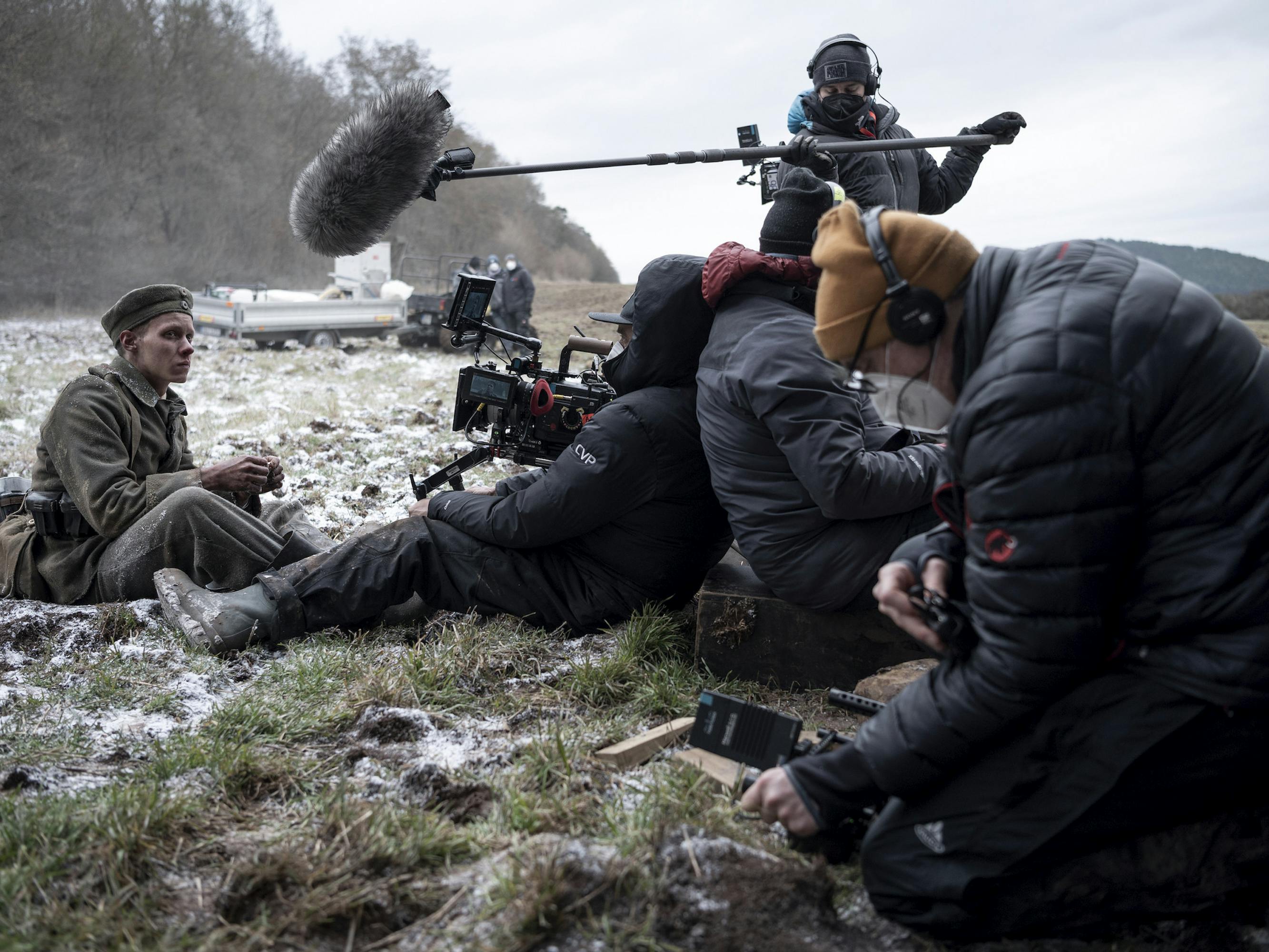
Felix Kammerer and crew behind the scenes
Volker, your soundtrack is so powerful when married to these images, this acting, this direction. What is your process? When did those notes come to you?
Volker Bertelmann: Well, I [came in] quite late in the process when the film was already in pretty good shape. I think that was the reason that I could imagine how the music could work with the sound, in a way, because there were a lot of sounds already in place where I could imagine using the sounds as an instrument as well.
I’m a big fan of John Cage, so sometimes I’m sitting on street crossings in Düsseldorf and I’m just listening to all the asynchronous sounds of the tram and the people that are talking and the wheels of the cars. Sometimes, in a surprising moment, they have a syncopation and they suddenly build a rhythm together. When I saw the film the first time, I had the feeling there were elements in there that could work with elements of music in a kind of collage together.
Edward said to me, “I want you to do something that you’ve never done before.” So, there was quite a bit of pressure on my shoulders. But at the same time, when you have somebody who’s challenging you, you actually have to find another road, which I love because suddenly I realize there’s a whole world [I didn’t know about].
So, On the way back from Berlin to Düsseldorf, I had a few thoughts. One was, I need an instrument from that time. I remembered a harmonium that I refurbished, from my great-grandmother. I was growing up in a very Christian area, and all the old people had a harmonium and they were singing accompanying Bach chorales with that. I love the base of harmoniums. And the pumping and the machine in it. And the second thought was, I need a very short fragment. I can’t write long lines of melodies with complex arrangements because one explosion is happening, and my whole composition is destroyed right in the middle.
The next day, 24 hours later, I wrote the very first piece. I was a little shy to send it to Edward because normally you collect, let’s say 10, 15 cues to make sure that at least one is right. But I had such a strong feeling about it that I had to send it to him. The next day he called me and he was cheering into the phone like, “Yes, this is it.” And that, of course, unleashed me to use those three notes in nearly every cue — even the trumpet player is playing those notes.
Berger: I called it the Led Zeppelin cue.
Bertelmann: Which is, I think, the adjective for head banging and stage diving.
Marcus, while we’re on the subject of audio, you are [tasked with] the kinetic part of this movie, the constant firing, the constant worry, heading into the next engagement. Talk about the challenges in your part of the shop.
Markus Stemler: Well, it was kind of a muddy business in a way. From the beginning, we knew that there would be lots of sound treasures at the set with all the historic vehicles and all these hundreds of extras running across the battlefield. We really wanted to make sure that we captured these unique sounds, to get this fingerprint of the war. So our production sound mixer managed to record loads of sounds for us, and this is how we started to create the foundation of the film.
We looked at it as a documentary almost, in the way we would treat the sound. We certainly didn’t want to wrap it in a pleasant sonic gift paper to make it an easier watch. But then, it’s a film that is from a very subjective perspective, and we try to mirror that in the sound by considering, How would things sound to Paul? When you’re driven by emotions, when you’re in a state of fear or in a state of shock, that really affects the way you hear.
So our approach actually prioritized emotional reality over historical accuracy, in a way. It always needed to match the emotional state of Paul. That’s why we shaped the sound and shifted the reality a little bit by making things sometimes bigger than they were and sometimes losing sounds because he was focusing just on one thing.
Filming an explosion
Frank, I cannot imagine the task of a visual effects supervisor on a film this kinetic. Is there a scene or a moment that you are most proud of in the film that perhaps we laypeople would not know because you did your job so well?
Frank Petzold: That’s always the problem with V.F.X. You do your job best when nobody knows it. But obviously the battle sequences, those three battles were quite hard work for all of us; it was physical work on set, but also in post-production, for almost seven months trying to put it together. It was challenging because we wanted to be invisible. We wanted to be respectful to the material, which is hard with V.F.X. because you want to be louder, bigger, flashier, and create more and more spectacle. Holding back and putting all our effort into detail was a big challenge. We employed techniques that actually aren’t done anymore nowadays.
Well, we layered certain elements together and tried to shoot it on set where usually you don’t get the time for that. Malte and Edward were very understanding on set that there were moments where I said, “Guys, I really need to get this element somewhere separately.” And they were like, “Well, if you need it, let’s get it.” Then, in terms of actual shots, the tank going over the trenches is a pretty cool thing.
With the side-firing. Brutal, lethal machine guns.
Petzold: They’re very graphic shots, but if you look at how we put it together, in terms of artistry, it really worked. There’s this one fabulous matte painting that we did that’s a wide-angle shot of the battle scene — since, in the movie, you are always with the soldiers, it’s the one view that you couldn’t actually see. I think that really brought the whole scenario together. You’re in the trenches with them, and at the same time, the viewer is the only person that has God’s view for a moment.
So, to the director, a final question. Folks in Europe, archivists especially, have tried very hard to preserve what they can of the trenches, the bomb craters from World War I. Have you paused to reflect that this film will be responsible for a new generation of fathers and mothers taking their children to see where the war to end all wars was fought?
Berger: Absolutely. When Malte called me and said, “Would you be interested in making this?” My immediate reaction was, “Damn, it’s going to be hard to get out of this one.” Because I’d read the book when I was 15 and then again when I was 22, and it immediately struck a chord. And then of course I read it many times during the rewriting and prep process.
But I’m always sort of ridden by doubts of, Which is going to be the next film? It’s a big decision because it’s two years of your life that you sign away with one yes. And who knows? It might end up terrible and then you wasted two years. So I go home, I discuss it at the dinner table, and my kids are [usually] utterly uninterested in my next project. That’s the last thing they want to hear about. So they scatter away. But I mentioned to my wife, “So Malte called, and it’s All Quiet on the Western . . .” The moment I mentioned All Quiet, my daughter, 17 at the time, whips around and says, “That book? I just read it in school.” I had no idea she read it. “If you have the chance to make that, you absolutely have to do it because it’s the best book I ever read, and it touched me deeply and I cried many times.”
That was a big reason because I thought, If 95 years after the publication of that book it still has such an impact on a young girl who’s certainly not the target audience for a book like that, then it must still have some relevance. I recognized that I had reacted exactly like her, but 40 or 35 years earlier. From generation to generation, that topic doesn’t leave us. The images in Ukraine look exactly like the images of 1916 Ypres that we used to recreate this battlefield.
